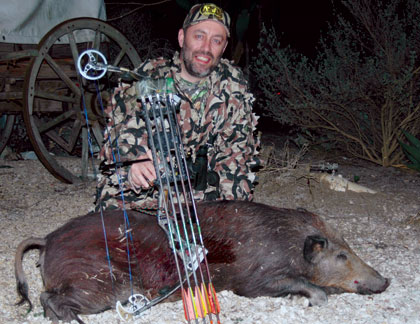March 16, 2011
Feral hogs, like deer, are an extremely adaptable and prolific species.
By Bob Humphrey
 If you want to keep your hunting skills sharp and equipment in good workingorder during the off-season, consider hunting feral hogs. Whitetails Columnist BobHumphrey killed this nice hog several years ago in South Texas. |
The sun had just dipped below the mesquite trees, and for the first time all afternoon I felt the air begin to cool. I'd carved a makeshift blind out of a clump of cedars and was eagerly awaiting the first whitetails when I felt, more than heard, the clumping of hooves on hard soil. My fingers tensed as I glimpsed a patch of brown moving through the cedars. My heart raced as I saw more shapes, then sank when the first stepped into the open. Hogs!
My disappointment was fleeting, however, when I realized this was not a problem, but an opportunity. The outfitter had not only warned me about the hogs, he had strongly encouraged me to reduce any and all I saw to possession. They might have already ruined my afternoon hunt for deer, but they certainly would if I let them hang around. So, I did what any self-respecting bowhunter would do. As I sent an arrow on its way I thought, Pork chops instead of back straps tonight!
Advertisement
Meet the Porcines
Feral hogs, like deer, are an extremely adaptable and prolific species. With a helping hand from humans, they have expanded their range over much of the Southeast and Texas -- and they continue expanding north and west.
Unlike deer, however, feral hogs are not a native species. They also compete with deer for many of the same resources and are increasingly becoming a wildlife management problem -- so much so that the Quality Deer Management Association devoted a section to feral hogs in its 2010 Whitetail Report.
Advertisement
Competition
Deer and feral hogs eat many of the same foods. On healthy range, it's not as much of an issue, but where food is limited, hogs can represent serious competition. The availability of both hard and soft mast can be an important factor as to how healthy deer are going into the winter, and hogs love mast. They're also more aggressive than deer, and thus may out-compete deer when food is limited.
Competition becomes even more of an issue on managed property. A landowner may spend hundreds or thousands of dollars building food plots. To the untrained eye, the effect of routine deer feeding is barely discernible. But hogs aren't as delicate. They can tear up a food plot in days. On more intensively managed properties, they'll also dominate feeders, taking hundreds of dollars in feed away from deer.
Depredation, Economic Impact and Disease
So often we depend on landowners, particularly farmers, for a place to hunt. Scratching a living from the earth is hard enough without adding feral hogs. They destroy crops, fences and other property. In Texas alone, the estimated annual agricultural damage from feral hogs is $52 million. In the Southeast, they cause significant damage in newly planted pine plantations. According to the QDMA report, "Feral swine can also carry at least 30 important viral and bacterial diseases and 37 parasites that can affect humans, pets and a variety of livestock and wildlife."
Silver Lining
In hunting, as in life, there are always two sides to every story; and it turns out feral hogs do have some redeeming qualities, not the least of which is their value as a huntable species.
Regulations vary considerably, and their status runs the gamut from game to nuisance animals. Some states allow limited take during certain seasons, while others have no closed season and no bag limit. Landowners have found they can even recoup some of their property damages through trespass fees, leases and other income related to hog hunting. And as their numbers increase, so does their value as a recreational commodity.
They're also fun to hunt. Like coyotes, another deer hunter's bane, feral hogs can be mere targets of opportunity on a deer hunt. If you tag out early on a guided deer hunt, many outfitters will let you hunt hogs at little or no additional cost. And then there's hog hunting as a deliberate effort.
Spring Training
Because they can be hunted year-round in many states, feral hogs also make for great off-season training to get or keep your deer-hunting skills in shape. Unlike other "off-season" game such as groundhogs or even turkeys, hog hunting requires virtually the same equipment as deer hunting. You also use essentially the same skills and tactics.
You may be hunting from fixed stands (often over a feeder or feeding area) or spot-and stalk hunting, and the latter can be extremely challenging. While their eyesight is less keen than a deer's, a hog's hearing is at least as good as a whitetail's, and their sense of smell is superior.
And while the challenge of hunting feral hogs is on par with that posed by whitetails, so is the payoff. I can tell you from firsthand experience the loins from a fat sow are every bit as tasty as the best venison backstraps!

